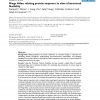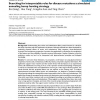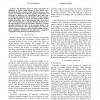66 search results - page 10 / 14 » Prediction of glycosylation sites using random forests |
BMCBI
2010
13 years 7 months ago
2010
Background: Biological processes in cells are carried out by means of protein-protein interactions. Determining whether a pair of proteins interacts by wet-lab experiments is reso...
BMCBI
2007
13 years 7 months ago
2007
Background: Relating features of protein sequences to structural hinges is important for identifying domain boundaries, understanding structure-function relationships, and designi...
BMCBI
2006
2006
Searching for interpretable rules for disease mutations: a simulated annealing bump hunting strategy
13 years 7 months ago
Background: Understanding how amino acid substitutions affect protein functions is critical for the study of proteins and their implications in diseases. Although methods have bee...
BMCBI
2010
13 years 7 months ago
2010
Background: The ability to design thermostable proteins is theoretically important and practically useful. Robust and accurate algorithms, however, remain elusive. One critical pr...
DMIN
2008
13 years 9 months ago
2008
The knowledge discovery process encounters the difficulties to analyze large amount of data. Indeed, some theoretical problems related to high dimensional spaces then appear and de...



